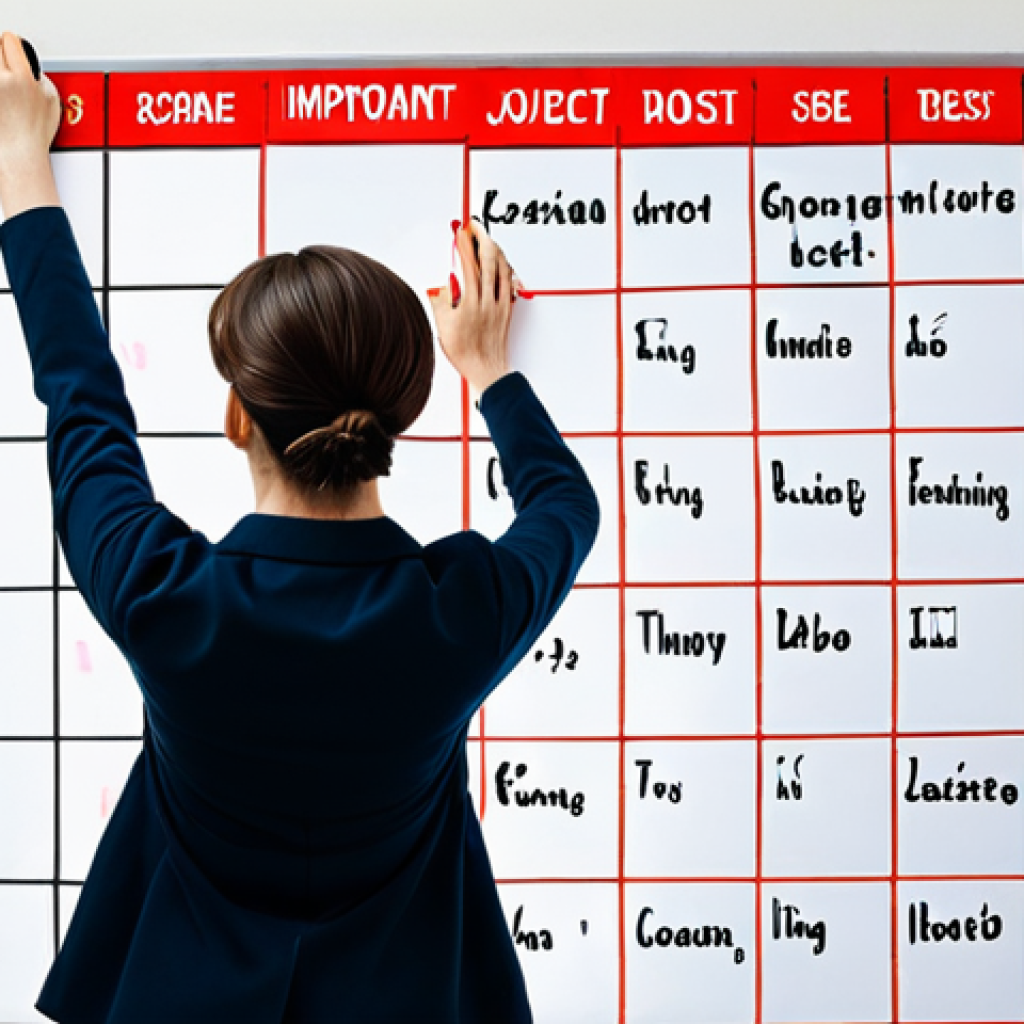We all crave that feeling of accomplishment, of ticking off tasks and conquering our to-do lists. In today’s fast-paced world, boosting productivity isn’t just a nice-to-have, it’s essential for staying afloat.
From juggling work deadlines to managing personal commitments, finding effective strategies to streamline our lives can make all the difference. I’ve been experimenting with various techniques myself, and let me tell you, some have been game-changers!
It’s about working smarter, not harder, and reclaiming those precious hours that seem to slip away. Let’s delve into the details and learn how to maximize your output!
Alright, let’s get those productivity levels soaring! Here’s a blog post ready to engage and help your readers achieve more:
Ditch the Overwhelm: Mastering Prioritization

It’s so easy to get bogged down by a mountain of tasks, feeling like you’re constantly putting out fires. Been there, done that! I remember one particularly chaotic week where I was juggling a major project at work, a family event, and a leaky faucet that seemed to be mocking my very existence.
The key to escaping this madness is learning to prioritize like a pro. It’s about identifying what truly matters and tackling those items first. Trust me, it’s a game-changer!
You’ll find yourself feeling less stressed and more in control. I’ve learned that the feeling of crossing off those vital tasks brings a sense of calm and accomplishment that filters into everything else you do.
1. The Eisenhower Matrix: Your Secret Weapon
The Eisenhower Matrix, also known as the Urgent-Important Matrix, is a powerful tool for prioritizing tasks. It’s a simple grid that categorizes tasks into four quadrants:* Urgent and Important: These are the tasks you need to do immediately.
Think deadlines, crises, or emergencies. * Important but Not Urgent: These are the tasks that contribute to your long-term goals and should be scheduled.
This is where strategic planning and proactive action come in! * Urgent but Not Important: These are tasks that often distract you from your priorities and should be delegated if possible.
* Neither Urgent nor Important: These are tasks that should be eliminated altogether. Social media scrolling and excessive TV watching often fall into this category.
2. The 80/20 Rule: Focus on What Matters Most
The Pareto Principle, or the 80/20 rule, suggests that 80% of your results come from 20% of your efforts. Identify those crucial 20% of tasks that yield the most significant impact and focus your energy there.
For example, in my blogging work, I realized that writing high-quality, engaging content (the 20%) was far more effective than spending hours tweaking my website’s design (the 80%).
Discovering that simple truth was a major lightbulb moment.
3. Saying “No” is Your Superpower
Learning to say “no” is an essential skill for boosting productivity. It’s about protecting your time and energy by declining commitments that don’t align with your priorities.
I know it can be tough, especially when you want to be helpful. However, saying “yes” to everything will quickly lead to burnout and overwhelm. Politely decline requests that don’t serve your goals or delegate them to someone else.
Your sanity (and productivity) will thank you.
Time Blocking: Structure Your Day for Success
Time blocking is a technique where you schedule specific blocks of time for specific tasks. Instead of simply having a to-do list, you allocate time slots in your calendar for each item.
This helps you stay focused and prevents you from getting sidetracked. I’ve been using time blocking for years, and it’s been instrumental in helping me manage my workload and stay on track.
Creating a visual representation of your day also gives you a better sense of control. I even use different colors for different types of tasks, adding a bit of visual appeal.
1. The Pomodoro Technique: Short Bursts, Big Results
The Pomodoro Technique is a time management method that involves working in focused 25-minute intervals, separated by short breaks. After every four “pomodoros,” take a longer break.
This technique helps maintain focus and prevent burnout. I find it incredibly effective for tackling tasks that I tend to procrastinate on. The short bursts of focused work make the task feel less daunting, and the regular breaks help me stay refreshed and motivated.
2. Theme Days: Focus Your Energy
Theme days involve dedicating specific days to specific types of tasks. For example, you could dedicate Mondays to meetings, Tuesdays to writing, and Wednesdays to administrative tasks.
This allows you to focus your energy and avoid context switching, which can be a major time-waster.
3. Minimize Distractions: Create a Focus Zone
Create a dedicated workspace free from distractions. Turn off notifications, close unnecessary tabs, and let your family or roommates know that you need uninterrupted time.
Consider using website blockers or noise-canceling headphones to further minimize distractions. I’ve found that creating a dedicated “focus zone” has been crucial for my productivity.
Even just tidying up my desk and putting away my phone can make a huge difference.
Automate and Delegate: Free Up Your Time
Automation and delegation are powerful strategies for freeing up your time and energy. Identify tasks that can be automated using technology or delegated to others.
This allows you to focus on higher-value activities that require your unique skills and expertise.
1. Tools for Automation: Streamline Your Workflow
There are numerous tools available to automate various tasks, from email marketing to social media posting. Explore these tools and identify those that can streamline your workflow and save you time.
I personally use tools like Zapier and IFTTT to automate repetitive tasks, and it’s freed up hours each week.
2. Delegation: Leverage Others’ Expertise
Delegation involves assigning tasks to others who are better suited to handle them. This could involve hiring a virtual assistant, outsourcing certain tasks, or simply assigning responsibilities to team members.
Be clear about your expectations and provide the necessary resources for them to succeed. Trust your team members to do their jobs! It not only frees up your time but also empowers others and fosters a collaborative environment.
Tools and Techniques: A Summary
Here’s a quick overview of the tools and techniques we’ve discussed:
| Tool/Technique | Description | Benefits |
|---|---|---|
| Eisenhower Matrix | Prioritizes tasks based on urgency and importance. | Helps focus on critical tasks and eliminate time-wasters. |
| 80/20 Rule | Focuses on the 20% of efforts that yield 80% of results. | Maximizes impact and minimizes wasted effort. |
| Time Blocking | Schedules specific blocks of time for specific tasks. | Promotes focus and prevents getting sidetracked. |
| Pomodoro Technique | Works in focused 25-minute intervals with short breaks. | Maintains focus and prevents burnout. |
| Automation Tools | Automates repetitive tasks using technology. | Saves time and streamlines workflow. |
| Delegation | Assigns tasks to others who are better suited to handle them. | Frees up time and leverages others’ expertise. |
Cultivate a Mindset of Productivity
Productivity isn’t just about tools and techniques; it’s also about mindset. Cultivate a positive and proactive attitude, and you’ll be amazed at what you can achieve.
I have learned that our frame of mind is essential to how productive we are during the day.
1. Set Clear Goals: Know What You’re Working Towards
Define your goals clearly and make them specific, measurable, achievable, relevant, and time-bound (SMART). Having clear goals provides direction and motivation.
Without clear goals, you’re just wandering aimlessly.
2. Practice Self-Care: Recharge Your Batteries
Taking care of your physical and mental well-being is essential for maintaining productivity. Get enough sleep, eat healthy, exercise regularly, and practice mindfulness.
Burnout is a productivity killer, so prioritize self-care.
3. Celebrate Your Successes: Acknowledge Your Achievements
Acknowledge and celebrate your successes, no matter how small. This reinforces positive behavior and motivates you to keep going. Give yourself a pat on the back for a job well done.
The Power of Breaks: Recharge and Refocus
Never underestimate the power of taking breaks. Stepping away from your work, even for just a few minutes, can significantly boost your focus and creativity.
It’s like hitting the reset button on your brain.
1. The Importance of Movement: Get Your Blood Flowing
Get up and move around every hour or so. Take a walk, do some stretching, or simply stand up and shake it out. Movement increases blood flow to the brain and helps you stay alert.
I personally love taking a quick walk around the block.
2. The Power of Nature: Connect with the Outdoors
Spending time in nature has been shown to reduce stress and improve focus. Take a break outside, even if it’s just for a few minutes. Breathe in the fresh air and soak up the sunshine.
3. Mindful Breaks: Disconnect and Recharge
Take breaks where you completely disconnect from work. Meditate, listen to music, or simply close your eyes and focus on your breath. These mindful breaks can help you recharge and refocus your mind.
Continuous Improvement: The Journey Never Ends
Boosting productivity is an ongoing journey, not a destination. Continuously experiment with different strategies, track your progress, and adjust your approach as needed.
Remember, what works for one person may not work for another, so find what works best for you. Embracing this mindset has been a real source of freedom for me.
You will be able to constantly get better and better with time. The key is that you have to start now!
In Conclusion
Boosting your productivity isn’t just about adopting the latest gadgets or apps. It’s about understanding what makes you tick, what drains your energy, and what fuels your passion. By implementing these strategies, you’ll find yourself not just accomplishing more, but enjoying the process along the way. So, here’s to a more productive and fulfilling journey! Now go out there and make some magic happen!
Handy Tips to Know
1. Eat the Frog: Tackle your most challenging task first thing in the morning. It gets it out of the way and sets a positive tone for the day.
2. Two-Minute Rule: If a task takes less than two minutes, do it immediately. It prevents small tasks from piling up.
3. Inbox Zero: Aim to clear out your email inbox regularly. Unsubscribe from unnecessary emails and create filters to organize your messages.
4. Power Nap: A short 20-30 minute nap can significantly boost alertness and cognitive function.
5. Mindful Coffee Breaks: Instead of mindlessly scrolling through social media during your coffee break, take a few moments to savor your coffee and clear your mind.
Key Takeaways
Prioritize effectively using the Eisenhower Matrix and the 80/20 rule.
Structure your day with time blocking and the Pomodoro Technique.
Automate and delegate tasks to free up your time.
Cultivate a mindset of productivity through clear goals and self-care.
Take regular breaks to recharge and refocus.
Frequently Asked Questions (FAQ) 📖
Q: I’m constantly overwhelmed with tasks. Where do I even begin to improve my productivity?
A: Oh, I totally get that feeling! It’s like staring at a mountain of laundry, right? My suggestion?
Start small! Instead of trying to overhaul your entire life in one go, pick one area where you feel the most bogged down. For example, if your email inbox is a black hole, commit to spending just 15 minutes each day clearing it out.
Use a tool like the “Pomodoro Technique” – 25 minutes of focused work, then a 5-minute break. Honestly, breaking things down into bite-sized chunks and celebrating those small wins makes a HUGE difference in motivation.
Personally, I found that using a simple to-do list app on my phone has been a game changer. Just seeing those tasks disappear after I crush them gives me a real buzz.
Q: I’ve tried time management techniques before, but I always seem to fall back into old habits. How can I make these changes stick?
A: Ah, the million-dollar question! I’ve been there, believe me. It’s not about finding the perfect technique, it’s about building sustainable habits.
Firstly, be kind to yourself. Slipping up is normal. Don’t beat yourself up; just acknowledge it and get back on track.
Secondly, figure out why you’re falling back. Are you setting unrealistic expectations? Are you trying to force yourself to do something you genuinely hate?
For me, I realized I hated using complicated planners. They just ended up gathering dust. Instead, I switched to a simple whiteboard where I could jot down my top 3 priorities each day.
It was so much less daunting, and I actually used it! Thirdly, reward yourself! When you achieve a productivity goal, treat yourself to something you enjoy – a fancy coffee, a new book, or even just 30 minutes of guilt-free Netflix.
Positive reinforcement is key!
Q: There are so many productivity apps and tools out there. How do I choose the right ones for me without getting overwhelmed?
A: This is a great question, and one I’ve struggled with. My advice? Don’t try to use them ALL!
It’s so easy to get caught up in the hype and download every app under the sun, but that’s a recipe for disaster. Think about your specific needs and pain points.
Are you struggling with task management? Focus? Communication?
Then, read reviews and try out a few free trials. But here’s the crucial part: give each tool a fair shot (at least a week or two) and then ruthlessly eliminate the ones that don’t work for you.
For instance, I tried using a complex project management tool for my personal life, and it was a complete flop. It was way too complicated! But I then found a simple note-taking app with a kanban board that fit my needs perfectly.
It’s about finding what resonates with your style and workflow. Don’t be afraid to experiment, but also don’t be afraid to ditch what isn’t working.
📚 References
Wikipedia Encyclopedia





